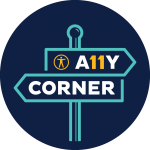Author: Heather Moorefield Lang, UNCG Accessibility Fellow

I have the privilege of teaching graduate students who plan to be instructional designers, librarians, web designers, educators, content creators, and more. Our students in the Department of Library and Information Science are out in the workforce creating online materials, websites, and content that will be used and seen by the public. Their creations will be used by all communities that include all ages and abilities. Due to that fact, I not only use accessibility measures in my own online teaching practices but I also teach about accessibility in digital content creation.
My students write reports, analyses, and papers like many others. They also create infographics, public service announcements, storytelling performances, makerspace designs, digital curations, and technology training plans. It is incredibly important for them to think of their users and audiences in the creation of their materials. Students in my department all have end users and their online materials need to be accessible to all, in the same way that my online course should be as well.
Some examples of what I teach my students:
Alt Text: Not only do I use alt text to describe my images in Canvas, PowerPoint, Google Slides and more, I also encourage my students to think proactively about using alt text while drafting presentations. It’s easier to add alt text while building a presentation than going back and adding it in later. I also talk to students about language for alt text, being concise and precise in our descriptions. This is an important skill for students to take into the workforce in education, UX in website design and programming, content creation in social media and gaming, along with so many other programs that we offer at UNC Greensboro.
Captioning: Videos in my courses are captioned. My live courses, due to the fact that I teach synchronously, are also captioned and recorded. I strive for my third-party content like Youtube videos and other shared materials to also be captioned for viewing. I emphasize the importance of captioning to my students who are content creators and the importance of captioning in video and similar media. Again it is so much easier to add the captions during initial creation than to go back and add later. Captioning can be useful for those who are deaf or hard of hearing, but captioning can also be handy for those who like to read captions while viewing a video, or a viewer who might need to watch a video quietly. Captioning is useful to all.
I also share a variety of sites with my students – sites they can use during college and after graduation. Some examples include:
- UNCG Accessibility Resources: I always share our own accessibility site with my students because we have an excellent set of resources on the topic of incorporating accessibility. I also feature our site due to the layout and ease of use. The ideas on the UNCG Accessibility site can also be used outside of the institution. I want students to see what accessibility resources can look like so they can build or recommend similar sites for their own school, university, company, or place of business.
- Youtube: Students already know about YouTube but I remind them that YouTube does automatic captioning. Not always perfect, but the content creator can edit captions. Students don’t always go into sectors with large budgets and I try to offer options that can be used with low/no budgets.
- Google Accessibility: I always show off the Google Accessibility site to my students for the sheer idea of it. Google showcases all of their different sites, devices, and apps on this site and shares each one’s accessibility tools. Regardless of it being Google I want my students to start paying attention to accessibility in technology. What is their favorite social media platform doing? What about their most used work resource? Does their webpage for their school or company feature accessible videos, text, and images? If not, it needs to change. I feature this site for awareness more than anything.
- Microsoft Accessibility: This is another great resource for students, especially as UNCG moves towards being an exclusive Microsoft campus. The Microsoft Accessibility site has several how-to videos for creating accessible content in MS Office. MS Office has made huge advances in accessibility, especially for Word documents, Excel spreadsheets, and PowerPoint slides.
As instructors in online and face to face settings, it is important to have accessible content; but making our material accessible goes far beyond our classrooms. We are teaching our students that equal access is important, valid, and should be our end goal. Having accessibility in our courses, discussing it, and showcasing how it is done, aids our students in knowing how accessibility can be achieved in their own fields once they leave UNC Greensboro.